How to Modify Shoes for Midsole Cleat
The first blog I ever posted nearly two years ago is still the most read. The subject was Cleat Position. That post has led to many questions on how to modify an old pair of cycling shoes in order to give it a try. I got another such query this week so it's probably time to explain how with a stand-alone post to save answering this question so frequently.
And to answer another common question on this topic: Yes, I do still use midsole cleats and have seen many others try it with good results, also.
If you decide to modify an old pair of your shoes you will more than likely need to use a mountain bike pedal with a two-bolt cleat as the arch area of most cycling shoes have a bit of a concave curve. That means there would be a gap between the middle of the cleat and the shoe if you used a three- or four-bolt cleat.
Here's how to modify your shoes. The pictures are of an old pair of Shimanos I changed over several years ago.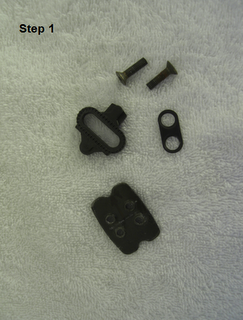 Step 1. Go to your local bike shop and in addition to mountain bike pedals and cleats get T-nuts and longer bolts than come with the cleats. Here is a picture of the parts you need. The T-nuts may be two, separate nuts instead of one, four-hole nut as shown here.
Step 1. Go to your local bike shop and in addition to mountain bike pedals and cleats get T-nuts and longer bolts than come with the cleats. Here is a picture of the parts you need. The T-nuts may be two, separate nuts instead of one, four-hole nut as shown here.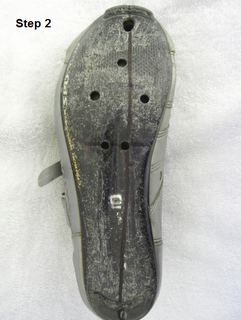 Step 2. After removing the old cleat draw a straight line from the middle of the toe of the shoe through the middle of the heel as shown in the picture. Measure to find the midpoint of that line and draw a second line perpendicular to the first.
Step 2. After removing the old cleat draw a straight line from the middle of the toe of the shoe through the middle of the heel as shown in the picture. Measure to find the midpoint of that line and draw a second line perpendicular to the first.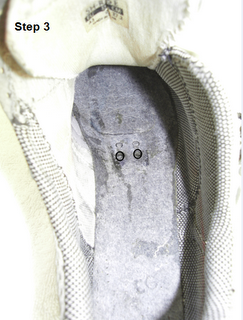 Step 3. Drill two holes on the second line that are spaced appropriately for your cleat and centered on the shoe widthwise. This is the tricky part. It's a good idea to check your measurements again before drilling. The picture here shows those holes from the inside of the shoe with the insole removed. This shoe happens to be smooth on the inside. That makes it easy. My wife's shoes had a recessed pattern of reinforcing squares which had to trimmed in order to insert the T-nuts.
Step 3. Drill two holes on the second line that are spaced appropriately for your cleat and centered on the shoe widthwise. This is the tricky part. It's a good idea to check your measurements again before drilling. The picture here shows those holes from the inside of the shoe with the insole removed. This shoe happens to be smooth on the inside. That makes it easy. My wife's shoes had a recessed pattern of reinforcing squares which had to trimmed in order to insert the T-nuts.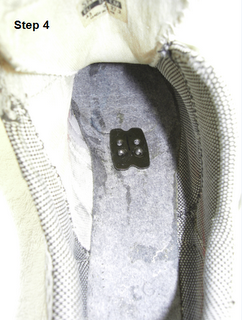 Step 4. Insert the T-nuts as shown here from the shoe's inside.
Step 4. Insert the T-nuts as shown here from the shoe's inside.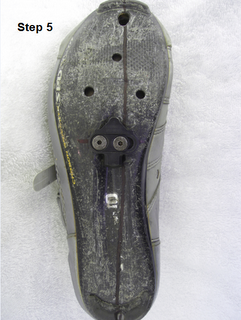 Step 5. Mount the cleats. Most of these two-hole cleats are adjustable for medial-lateral positioning as shown here. But I've seen some that aren't. If you can't slide it from side to side a bit then the position of the holes becomes even more critical. You could wind up with your feet too wide or too narrow once clipped in. So it's best to get cleats that are adjustable.
Step 5. Mount the cleats. Most of these two-hole cleats are adjustable for medial-lateral positioning as shown here. But I've seen some that aren't. If you can't slide it from side to side a bit then the position of the holes becomes even more critical. You could wind up with your feet too wide or too narrow once clipped in. So it's best to get cleats that are adjustable.
Be aware that with a midsole cleat you are likely to have a considerable overlap of the shoe with the front wheel. This makes slow turns a bit dangerous. If your shoe touches the wheel during a turn you may fall. You will eventually get used to this and learn to make slow turns with your outside foot out of the way of the wheel.
Labels: cleat position, midsole


15 Comments:
Very informative DIY article, thanks!
Thanks for your technical & sports science articles and books Joe. I've just reread your item Q&A: Aging and Injuries from November 7, 2008 and it has given me fresh hope during a prolonged recovery from radial nerve damage.
Have you had anyone try this with look style pedals? I really appreciate your blog. Thank you for all of the valuable information that you continually post.
Derek
Joe,
How does this foot position change effect the knee to pedal spindle relationship from standard bike fit theory?
Thanks!
Guido
Derek--I had one athlete have custom shoes made who uses Keos. But don't know of anyone who has modified shoes to use Looks. Again, may not be possible due to the arch curve of most shoes.
guido--no change at all. it's still KOPS.
Hello Joe,
With the cleats in the middle sole the shoe front could touch the wheel when you are doing a turn. Couldn't it?
Regards from Chile,
Roberto
Roberto--yes, it can happen. See 3rd paragraph from end for more on this.
I am hoping some shoe manufacturers are tuning in to your blog and triathletes who are using this set up and will be making these-at least front or mid options for those of us too lazy to want to go through this whole process!
I would be interested in reading more about this from riders who have switched over!
Thanks!
I remember your post from a couple of years ago regarding midfoot cleat position and I hoping, both then and now, that someone would publish some power data on the different positions. It seems to me that the midfoot cleat position would reduce the lever arm length of your leg, especially for your gastrocs, and therefore reduce your power production.
Thanks for the great blog and book.
TJ--I'd like to see that also. So far the few studies I've seen looked at economy and not power per se. Don't have the refs with me now (in Boulder for holidays) but basically, if my memory serves me here, they showed that it didn't matter where you had your cleats when it comes to economy - any where from arch to heel. Of course, all of the subjects in these tests had years of adaptation to traditional cleat positions. That suggests to me that other positions may be better if even with no adaptation the athletes' economy was as good as with their fully adapted positions.
Great post!
regarding adjustments after moving back, for someone on a Tri Bike running about a 77 degree seat angle an reccomendations on what to changes to make to my saddle height and fore/aft ?
Hi Matt--Really can't say with any certainty. Will more than likely have to lower saddle. That will it forward a bit. Then get knee relative to pedal same as you had it before. best to have a pro do this.
Thanks Joe
for having made my finding so popular amongst your audience during the last two years.
Let me take the opportunity and comment on some of the FAQs which puzzle people not familiar with the facts behind bio-mxc²/midfoot pedaling.
Downstroke gets extended when placing the cleat midfoot under the shoe. Therefore
PEAK POWER necessary to propel a bike at equal speed will get notably diminished. As it is peak power which makes muscles tire out quicker those who take advantage of shoes which support midfoot cleats persevere longer, recover quicker and suffer convincingly less tendon and muscle ailments.
Those who want to visualize the above mentioned click on http://biomac.webstudios.at/index.php?option=com_content&view=article&id=16&Itemid=9&lang=en
and find a simplified image of what my finding is all about.
For du- and triathletes who run after their ride and those who must deliver long distance performance at very high levels such as a RAAM this almost invisible and 100% legal modification turned out to be a decisive tool when it comes to tackle the top.
Reducing CALF muscles' work, less lifting action for the passive leg, zero foot burn and minimized pressure on knees and achilles tendons present positive 'side effects' for any cyclist who resort to my solution.
SCIENTIFIC PROOF was never of main concern for me as I was too busy making shoes for Joe and others.
However, I have piles of torque graphs which deliver convincing evidence of the above mentioned: more economic pedal action, less fatigue and more efficiency. If you want to display them in this blog Joe, it will be my pleasure to send some of them.
Hi Goetz--Thanks for your post. I believe I may have seen those graphs but feel free to send them my way.
Post a Comment
<< Home